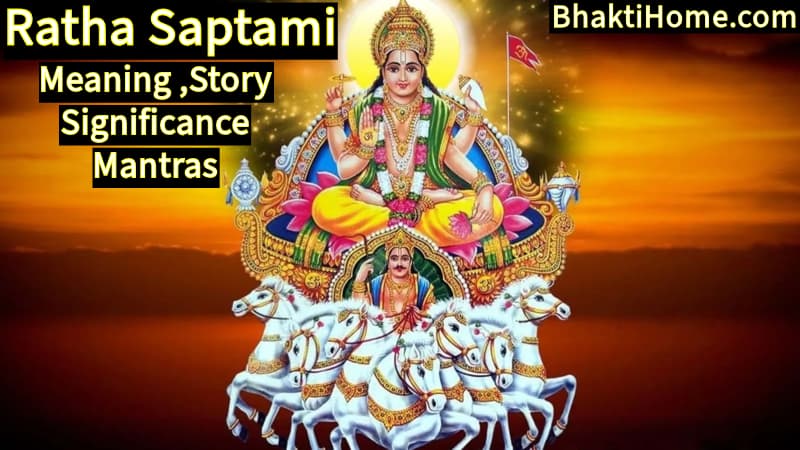
Ratha Saptami: Meaning, Story, and Significance
Ratha Saptami is a Hindu festival celebrated on the seventh day (Saptami) of the bright fortnight (Shukla Paksha) in the month of Magha (January–February). It is also known as Surya Jayanti, marking the symbolic birth of the Sun God. The day signifies the transition of the Sun towards the northern hemisphere and is considered highly auspicious.
Ratha Saptami Story
According to Hindu mythology, Ratha Saptami commemorates the time when Lord Surya (Sun God) began his journey in a chariot driven by seven horses, symbolizing the seven colors of light and the seven days of the week. The journey of the Sun across the sky is essential for sustaining life on Earth, representing prosperity and enlightenment.
Another legend says that King Yashovarma of Kamboja was childless until he worshipped the Sun God on Ratha Saptami. As a result, he was blessed with a son, highlighting the day’s association with fertility and health.
Ratha saptami significance
- Symbol of Renewal and Growth: The day symbolizes new beginnings, prosperity, and health as the Sun becomes more potent.
- Spiritual Cleansing: It is believed that taking a bath during Ratha Saptami removes sins and bestows good health.
- Agricultural Importance: Ratha Saptami marks the beginning of the harvest season in India, particularly in South India.
- Sun Worship: The festival emphasizes gratitude to the Sun God for providing energy, light, and life.
Ratha Saptami Rituals
- Early Morning Bath:
Devotees wake up before sunrise and take a ritual bath using erukku leaves (Calotropis) placed on the head, shoulders, and knees.- Mantra while bathing:
Sapta Saptivyah Saptayuktah Rathasthithah
Suryo Brahmane Namah
- Mantra while bathing:
- Sun Worship:
Devotees offer prayers facing the east and perform Arghya (water offering) to the Sun while chanting mantras like the Aditya Hridayam. - Special Rangoli:
Houses are decorated with beautiful kolams or rangolis, often depicting chariots with horses to symbolize the Sun's journey. - Lighting Lamps:
Diyas are lit, and offerings are made to Lord Surya, including flowers and special foods. - Charity:
Donations to the poor, especially food and clothing, are encouraged on this day.
What Should We Do on Ratha Saptami?
- Take a bath before sunrise while reciting Sun-related mantras.
- Perform Surya Namaskara (sun salutations) and chant the Gayatri mantra.
- Offer water to the Sun.
- Prepare and offer special dishes to the deity.
- Practice gratitude by making charitable donations.
What to Eat on Ratha Saptami?
On Ratha Saptami, people typically prepare and consume dishes made from rice, jaggery, and seasonal produce. Some common dishes include:
- Sakkarai Pongal (Sweet Pongal)
- Payasam (Kheer)
- Steamed rice with ghee and jaggery
- Seasonal fruits and coconut-based dishes are also offered as naivedyam.
Is Ratha Saptami Good or Bad?
Ratha Saptami is considered extremely auspicious. It is a time for purification, new beginnings, and positive energy. Worshipping the Sun on this day is believed to eliminate sins, bring health, wealth, and spiritual growth.
Why Do People Celebrate Ratha Saptami?
- To honor and express gratitude to the Sun God for sustaining life.
- To seek blessings for good health, prosperity, and spiritual advancement.
- To mark the Sun’s movement towards the north, symbolizing increased positive energy.
Powerful Mantras to Chant on Ratha Saptami
1. Surya Gayatri Mantra
Sanskrit:
ॐ भास्कराय विद्महे
महातेजाय धीमहि
तन्नो आदित्यः प्रचोदयात्
English Transliteration:
Om Bhaskaray Vidmahe
Mahatejaya Dheemahi
Tanno Adityah Prachodayat
Meaning:
- Hindi: मैं भगवान भास्कर (सूर्य) का ध्यान करता हूं, जिनकी अद्भुत ऊर्जा है। कृपया मेरी बुद्धि को प्रेरित करें और मुझे सही दिशा प्रदान करें।
- English: I meditate upon Lord Bhaskara (the radiant one) and Mahateja (the brilliant one). May the Sun God illuminate my mind and guide me.
2. Saptashva Ratha Mantra
Sanskrit:
सप्त सप्तैव सप्त युक्त रथस्थितः
सूर्यो ब्रह्माणेष्टु मां रक्ष सूर्य नमोस्तुते
English Transliteration:
Sapta Saptaiva Sapta Yukta Rathasthitaḥ
Suryo Brahmaneṣṭu Māṃ Rakṣa Surya Namostute
Meaning:
- Hindi: सात घोड़ों से युक्त रथ पर सवार सूर्य देव को प्रणाम। वे ब्रह्मा की इच्छा पूर्ति करने वाले हैं। कृपया मेरी रक्षा करें।
- English: Salutations to the Sun God, who rides a chariot drawn by seven horses and fulfills the will of Brahma. Please protect me.
3. Arghya Mantra (Offering Water)
Sanskrit:
ॐ सूर्याय नमः
ॐ आदित्याय नमः
ॐ भास्कराय नमः
English Transliteration:
Om Suryaya Namah
Om Adityaya Namah
Om Bhaskaraya Namah
Meaning:
- Hindi: सूर्य देव, आदित्य देव और भास्कर देव को मेरा प्रणाम।
- English: Salutations to Lord Surya, Aditya, and Bhaskara.
4. Surya Ashtakam (First Verse)
Sanskrit:
नमः सूर्याय शांताय सर्वरोग निवारकाय
आयुरारोग्यमैश्वर्यं देहि मे जगताम् पते
English Transliteration:
Namah Suryaya Shantaya Sarvaroga Nivarakaya
Ayurarogyam Aishwaryam Dehi Me Jagatam Pate
Meaning:
- Hindi: हे शांत सूर्य देव, जो सभी रोगों का निवारण करते हैं। मुझे आयु, आरोग्य और ऐश्वर्य प्रदान करें।
- English: Salutations to the calm Lord Surya, the remover of all diseases. Grant me health, longevity, and prosperity.
5. Om Namo Suryaya Mantra
Sanskrit:
ॐ ह्रीं सूर्याय नमः
English Transliteration:
Om Hrim Suryaya Namah
Meaning:
- Hindi: हे सूर्य देव, आपको नमस्कार। कृपया मुझे शक्ति और प्रकाश प्रदान करें।
- English: Salutations to Lord Surya. Please bless me with strength and illumination.
Chanting Tips
- Perform these chants during sunrise while facing the Sun.
- Offer Arghya (जल) to the Sun God.
- Meditate on the Sun’s energy as a source of vitality and positivity.
Examples of Celebrations
In South India, particularly Tamil Nadu and Karnataka, temples such as the Suryanarayana Temple in Andhra Pradesh witness grand celebrations.
Devotees gather to perform elaborate rituals and participate in spiritual discourses.

